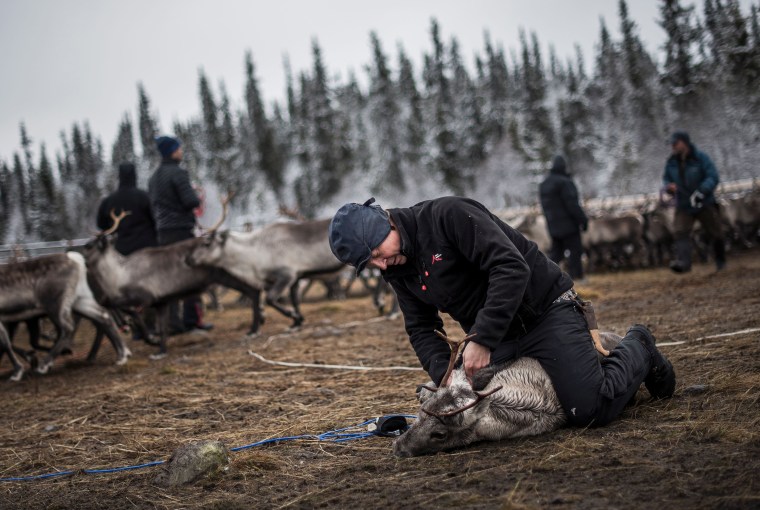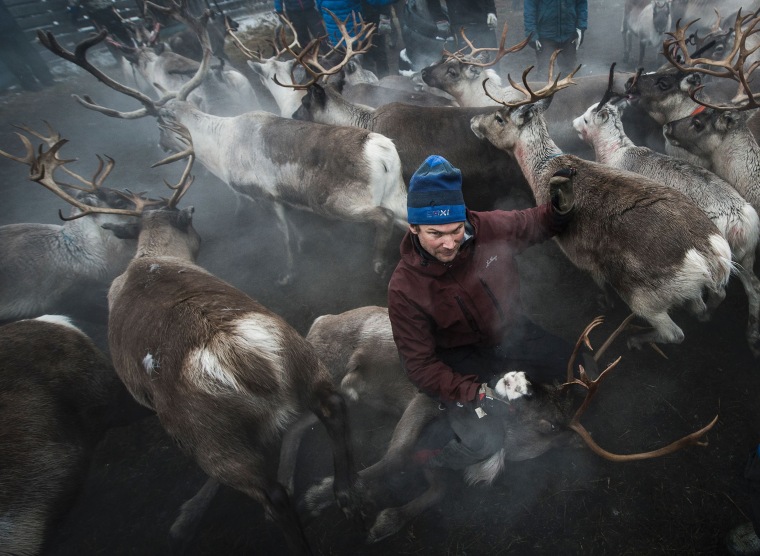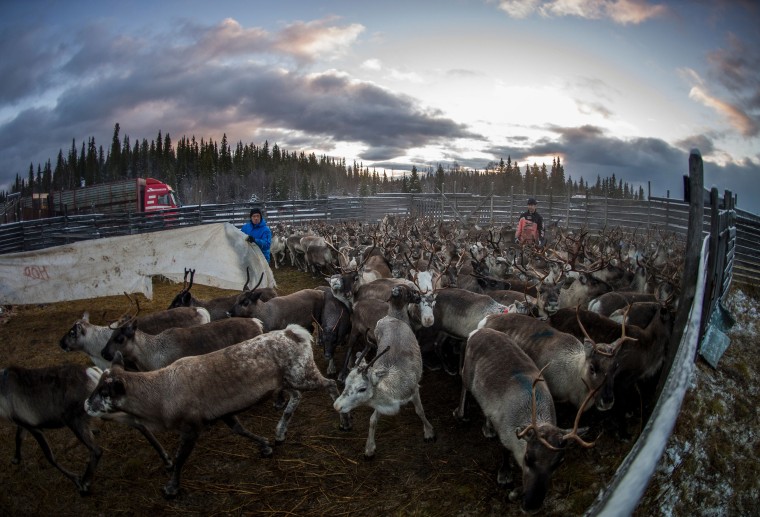It may be December but almost 100 miles north of the Arctic Circle there’s still not enough snow for reindeer to begin their annual migration.
Sweden’s indigenous Sami people have herded the animals for generations, with the corral usually happening over a two-week period in November.
But this year the tradition has been postponed because temperatures keep fluctuating above and below the freezing mark.
“Something is really wrong with nature,” said Niila Inga, 37, who lives in Sweden’s northernmost town of Kiruna. “I can't ask my father what to do now because he hasn’t seen this; it hasn’t happened during his lifetime.”
The past four years have been the warmest on record globally, according to the World Meteorological Organisation.
Reindeer husbandry is carried out in countries throughout the Arctic including Norway, Russia and China. A 2009 report on the future of the practice says that there are 3,000 reindeer herders in Sweden alone, and a total of nearly 100,000 globally.
It's a family business. Inga said he took the lead from his father when he turned 18 and works alongside 17 other full-time herders in the community that includes his cousins and nephew.
Every September, reindeer are gathered and killed for meat. It’s the main source of income for the herders.

After the slaughter, the remaining reindeer are left to graze in the wild until it’s time for the winter migration eastward to better grazing territory. For Inga, that's a trek of more than 62 miles.
Herders follow the animals on snowmobile, spending nights in cabins along the route. Children get the time off school to take part in the process.
“Everything is connected to the reindeer and the reindeer herding,” Inga said. “It’s something you’re born and raised in.”
But Inga, who is also the chairman of the Swedish Sami Association, believes "something is shifting."
The snow is vital to every aspect of reindeer husbandry so this winter's erratic freeze-thaw cycle is a problem.
Research suggests the effects of global warming are amplified at the poles, with average air temperatures rising faster than elsewhere on the planet. This results in the rapid loss of ice, according to the National Snow and Ice Data Center in Colorado. This year's winter freeze is being forecast to come late for the Scandanavian region and ice formation will be below-average.
The herders need the snow for their own travels through the wild terrain. Snow also makes it easier for the Sami to track reindeer and predators.
Most importantly, the snow impacts vegetation. A delayed winter could be viewed as a good thing, allowing the reindeer more time to graze by the mountains, Inga said. But it could also lead to the reindeer trampling the plants and prompt overgrazing.
Research is backing up the changes the Sami are witnessing. Gunhild Rosqvist, a geography professor at Stockholm University, is part of a team studying the changing Arctic landscape, including the accelerating loss of glacier ice in the Scandinavian mountains.
Rosqvist is currently working with the herders to study how weather variability is impacting the animals.
It's becoming clear the animals are migrating into new areas — despite roads and other development blocking their path — which in turn is forcing herders to change their practices, she said.
The expansion of mining, wind-energy farms and tourism across northern Sweden is cutting back on the available land.
The entire town of Kiruna is being forced to move because of the neighboring iron ore mine.
“The combined pressure of all this and climate change is really pushing some of these communities over the tipping point,” Rosqvist said.

Reindeer migration is just one of the many symptoms of the warming climate.
This summer saw Sweden’s highest peak lose that status due to glacial melt while wildfires spanned an unprecedented 61,775 acres across the country amid record hot and dry conditions.
A huge section of a glacier near Rosqvist's northern research station unexpectedly broke loose in an ice avalanche, she said, shocking scientists.
“It’s an emergency,” Rosqvist added. “The whole ecosystem is so delicate.”
Despite the rapid changes to the landscape, the Sami are trying to adapt. Inga said herders are discussing what to do if the land fails to provide enough food for the reindeer.
“We don’t want to feed them because it isn’t natural and it’s part of our culture,” Inga said. The reindeer are semi-domesticated and bringing in food could change their behavior dramatically, he said. It could also affect the quality of the meat.
Sanna Vannar, president of the Sami youth association Sáminuorra, said members hope that they’ll be able to continue the traditions of their forefathers.
The association joined 10 families across Europe and Africa to lodge a lawsuit against the European Union in May for failing to reduce greenhouse gas emissions responsible for climate change.
The lawsuit specifically cites the challenges reindeer are having in finding food due to the warming climate and the repercussions it, in turn, has on Sami culture and livelihoods.
"It's really bad for young reindeer herders because they every day have to think about the weather," Vannar said. "I can't see my life without reindeer."




